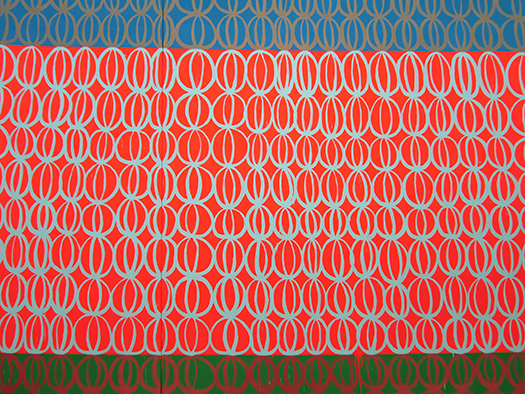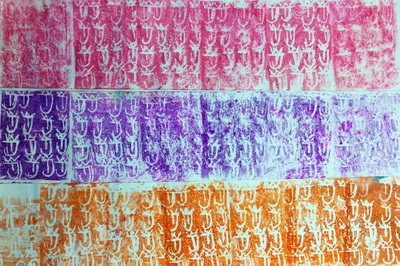|
We just finished up learning about contemporary artist, Judy Ledgerwood. Judy is a Chicago-based artist who is influenced by textiles and the pattern/decoration artists of the 1970s. She repeats a motif over and over with slight variations of the design throughout the painting. While Judy is a painter, we practiced our printmaking skills for the project.
We started the project with a worksheet that used our initials to create a design. After creating three initial designs, students chose one and then redrew that design over and over on a small slip of paper. Then they took that slip of paper and taped it to a piece of styrofoam and retraced all of their initial designs with a pen. By doing this, it presses parts of the foam in and creates a relief print. The second day was spent finishing up their designs and styrofoam. Then we talked about relief printing and I showed them a quick video of what a relief printer does. I then showed them how we would use our styrofoam as a relief print. Students colored their styrofoam with a washable marker. I then went around and sprayed their strip of water with a spray bottle. They wiped off the extra water with a sponge so that their paper was damp and then printed their styrofoam onto the damp paper. Lastly, they gently rolled over their styrofoam with a brayer to make sure that they smoothed all the edges. Having them use the brayer as a smoother really helped their prints turn out better. Students printed for about two and a half days. They were expected to print the same color all the way across their strip of paper, over and over. When they finished a strip, they could choose another color and do it all over again. They had to finish at least 3 strips of paper but were welcome to print more. The last day was spent choosing their 3 best strips of paper and gluing them down onto a larger sheet of paper so that it made one large artwork.
0 Comments
My goal with 3rd grade this is to introduce them to a completely contemporary curriculum. They will be introduced to famous artists of the past all throughout their life. I want to shed light on artists of today. This is an area that is typically overlooked when teaching.
Kicking off the year, we learned about one of my favorite artists, Kehinde Wiley. Kehinde is an African-American portrait artist. Growing up in a rough neighborhood in LA, his mom enrolled him in as many art classes as she could to keep him out of trouble and this really fostered his artful side. His work focuses on the lack of black people throughout art history. He has taken it upon himself to re-paint history. His work shows appropriated paintings from master painters. However, he replaces typically white powerful men in the paintings with young black men in their hip hop/urban attire. He also replaces the traditional background with a patterned one that is influenced by the depicted man’s culture. While our school is vastly of Euro-American decent, the students were super interested in Kehinde’s work and his struggle to give blacks a place in art history. The first day of class was spent talking and practicing drawing self-portraits. I gave them 5 minutes to draw a self-portrait without any help from me. Nearly all students drew their self-portraits with their eyes on their foreheads, their nose where their eyes belong, etc. After the five minutes, we re-convened and I talked to them about where each facial feature actually belongs. After their crash course in portraits, they began working on a larger final version of their self-portrait. The 2nd day of class is when I introduced Kehinde’s work to them. They continued to work on their self-portraits and if they finished early, they began tracing their self-portraits with a sharpie. The 3rd day of class we finished up drawing and tracing and erasing our self-portraits. Then students painted their respective skin tones. If they finished all of that, they began working on a stamp that we would use to print their backgrounds. The 4th day was spent painting the rest of their self-portrait (hair, clothes, eyes, etc). They also continued working on their background stamp. The background stamp consisted of a piece of tagboard with pieces of foam attached to it. The previous art teacher before me left behind a bunch of foam pieces that have sticker backing on them. Students cut up these pieces of foam and attached them to the tagboard. The last day of the project was spent cutting out their self-portraits. Then they used their foam stamp to print a pattern across the background before gluing down their self-portrait. This was a long project for the students but they really seemed to dig learning about one of my favorite artists! |
Devon CalvertHarmony and Consolidated Elementary Art Teacher in Milton, WI. UW-Eau Claire graduate. WAEA President. Apple Teacher. Archives
March 2019
Categories
All
|















 RSS Feed
RSS Feed
